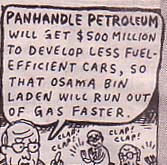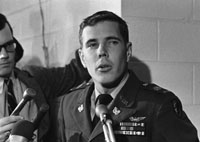by Gary North
July 4, 2002
The best way to destroy the public’s memory of an
important event is to make it into an American national
Every Christmas, Americans celebrate the arrival of a bearded, red-suited Communist who looks suspiciously like Karl Marx, and who gives presents to everyone, irrespective of race, color, creed, or national origin. Parents tell their children that only good little boys and girls are so rewarded, but the kids catch on fast: they’re going to get some of the loot, no matter what. Also, they never think that their share of the booty is fair. This prepares them to be voters.
Then there is Easter, the celebration of a rabbit who,
for some unexplained reason, hides colored hard-boiled
chicken eggs in everyone’s back yard and on the White
On New Year’s Day, people recover from hangovers by watching the Rose Parade, a TV show so excruciatingly boring that it looks as though it was produced by PBS with a major government grant. (Note: it was to comment on the Rose Parade that national TV networks first brought in women to serve as “colorful” co-anchors, something for which the original producers will answer for on judgment day.) Later in the day, tens of millions of men watch college football bowl games, most of which settle nothing, but one of which unofficially determines which major team was the best during the season — an exclusively past-oriented celebration for the new year.
On Thanksgiving Day, only those people give thanks
whose favorite college football team wins the annual Big
Game with the school’s major rival.
On Presidents Day, we celebrate the birth of two men with two things in common: they were born in February, and they were twice elected President. Because we combine their birthdays, we learn nothing about either of them.
On Labor Day, nobody works.
On Memorial Day, nobody remembers World War I.
Because there has been insufficient time to transform
the holiday into something else, Martin Luther King Day
still officially honors the birth of Michael King (aka
Martin Luther King, Jr.). About 80% of Americans do their best to forget, and 10% — immigrants — never knew.
This brings me to the Fourth of July. There are no
Fourth of July parades on TV, or anywhere else, as far as I know. I cannot remember any in my youth.
We have all heard the phrase, “a Fourth of July
oration.” Maybe in my parents’ day, or my grandparents’
day, but not in mine. I do not recall ever hearing a
single patriotic speech on the Fourth of July.
On July Fourth, we set off fireworks. But fireworks
have nothing to do with the great event of the Fourth of
July. Fireworks are associated with the national anthem,
which was composed for British War II (1812), not British War I.
Public fireworks are almost always funded by tax
money, since there is no way to keep non-paying viewers
from watching. But as government expenditures go,
fireworks should be the model for all government
expenditures: only once a year, no full-time employees,
funded locally, benefits are not means-tested, access is
first come-first served, no politician gets any credit, no
mailing lists are involved, and Congress always shuts down during the show.
Americans get most of their knowledge of history from movies.
Think of the movies about the American Revolution that were made in Hollywood’s golden era. There was. . . .
There were a few swashbucklers that were set in the
late eighteenth century, but none of them is about
defending the traditional rights of Englishmen.
I don’t count “Johnny Tremain,” a 1957 Disney film
based on Catherine Drinker Bowen’s novel. It was Hal
Stalmaster’s first and last movie. He later decided —
wisely, I think — that he could make more money as an
actors’ agent than as an actor, especially since his
brother owns one of Hollywood’s major casting agencies.
The movie isn’t bad, but ultimately it was a “Luana Patten, almost grown up” movie, which did not bode well for it. (Miss Patten was Disney’s late 1940’s version of Shirley Temple, except that she couldn’t dance or sing.)
Of course, there is “The Patriot.” It doesn’t deal
with ideology. It’s initially the story of a politically
uninvolved man who is trying to save his son from a
murderous Redcoat. A similar theme governs “Revolution,” with Al Pacino. It is about a man who wanted no part of the war, but whose son gets persuaded to sign up, so he signs up to protect his son. His patriotism grows out of the war experience. It does not precede it.
“The Last of the Mohicans” is about Mohicans. Its
soundtrack is more memorable than its script.
There are more movies about Wyatt Earp than about
Thomas Jefferson or George Washington.
Let’s face it: movies about people who write with
quills don’t make a lot of money. This is why there are
not many French Revolution movies, either.
For most Americans, the story of the American Revolution is more like a series of museum displays with toy soldiers than a series of events that grab our collective imagination. Other than George Washington, the most famous general of the American Revolution is Benedict Arnold. In third place is Gentleman Johnny Burgoyne. He was a Brit, and he is famous only because of “Gentleman.”
In my library are boxes of microcards. Each card
contains tiny images of up to 200 pages. On these cards is every document published in the United States from 1639 to 1811. Yet I rarely consult those cards. I have shelves of books on the American Revolution. I rarely pull one of them down and read it. I read McCullough’s “John Adams,” but so did a million other people — or at least they bought the book. Thirty years ago, I earned a Ph.D. with a specialty in colonial American history, although my sub-specialty was New England, 1630-1720, not the American Revolution. But even for me, the events and the issues of 1776 have faded. Think of the average American high school graduate, whose history class spent two weeks on the American Revolution two decades ago.
There was a slogan: “No taxation without representation.” How did that slogan turn out? In 1776, there was no income tax. So, we got our representation, but taxes today are at 40% of our income. Washington extracts 25% of the nation’s output. In 1776, taxes imposed by the British were in the range of 1% in the
North, and possibly 3% in the South. I’m ready to make a deal: I’ll give up being represented in Washington, but I’ll get to keep 74% of my income. I’ll work out something else with state and local politicians. Just get Washington out of my pocket.
Jefferson put these words into the Declaration of
Independence:
He has erected a multitude of New Offices, and
sent hither swarms of Officers to harrass our
people, and eat out their substance.
He had no idea. Not counting troops, who were here to defend the Western territory from the French after 1763, the number of British officials was probably well under a thousand. They resided mainly in port cities, where they collected customs (import taxes): Boston, New York, Philadelphia, and Charleston. The average American had never met a British official in 1776.
By any modern standard, in any nation, what Jefferson wrote in the Declaration to prove the tyranny of King George III would be regarded by voters today as a libertarian revolution beyond the dreams of any elected politician, including Ron Paul. Voters would
unquestionably destroy the political career of anyone who would call for the restoration of King George’s tyranny, which voters would see as the destruction of their economic security, which they believe is provided only by politicians and each other’s tax money.
I have therefore revised the Declaration of Independence, in order to make it conform to the prevailing American view of liberty and justice for all. You may read my revision here:
This is why the documents of the American Revolution make no sense to us. We read the words and marvel at the courage of those who risked their lives, fortunes and sacred honor by signing the Declaration. But we cannot really understand why they did it. We live under a self-imposed tyranny so vast, so all-encompassing by the standards of 18th-century British politics, that we cannot imagine risking everything we own in order to throw off the level of government interference suffered by the average American businessman in 1776, let alone the average farmer.
If we could start politically where the Continental
Congress started in 1775, we would call home the members of
that Congress. We would regard as crazy anyone who was
willing to risk a war of secession for the sake of throwing
off an import tax system that imposed a 1% burden on our
income.
The Declaration of Independence points a finger at us,
and shouts from the grave on behalf of the 56 signers:
“What have you done? What have you surrendered in our
name? What, in the name of Nature and Nature’s God, do you
people think liberty is all about?”
We have no clue. American voters surrender more
liberty in one session of Congress than the colonists
surrendered to the British crown/Parliament from 1700 to
1776.
We do not read the documents of the American
Revolution. They make us uneasy and even guilty when we
understand them, and most of the time, we do not understand them. They use language that is above us. The common discourse of American politics in 1776 was beyond what most university faculty members are capable of understanding.
You think I’m exaggerating. I’m not. My friend
Bertel Sparks used to teach in the Duke University Law
School. Every year, he conducted an experiment. He wanted to put his first year law students — among the cream of
the crop of American college graduates — in their place.
He assigned an extract from Blackstone’s Commentaries
on the Laws of England. This was the most important legal
document of the American Revolution era. It was written in
the 1760’s. Every American lawyer read all four volumes.
It was read by American lawyers for a generation after the
Revolution. Sparks would assign a section on the rights of
property. He made them take it home, and then return to
class, ready to discuss it.
When they returned, they could not discuss it. The
language was too foreign. The concepts were too foreign.
The students were utterly confused.
Then Sparks would hold up the source of the extract
from Blackstone. The source was the Sixth McGuffey reader, the most popular American public school textbook series of the second half of the 19th century.
That put the kiddies in their place.
If you want to be put in your place, pick up a copy of
the Sixth McGuffey reader and try to read it.
Try to read the “Federalist Papers.” These were
newspaper columns written to persuade the voters of New
York to elect representatives to ratify the Constitution.
These essays were political tracts. They were aimed at the
average voter. Few college graduates could get through
them today, so students are not asked to read them in their
American history course, which isn’t required for
graduation anyway.
WHAT HAVE WE DONE TO OURSELVES?
Our march into what Jefferson would have described as
tyranny has been a self-imposed march. Voters today would be unwilling to go to war to restore the Declaration’s
ideal of liberty. In fact, Americans would go to war to
keep from having the Declaration’s ideal of liberty from
being imposed on us. By today’s standards, King George III was indeed a madman: a libertarian madman, a character out of an Ayn Rand novel that never got published. On politics and economics, Jefferson was madder than King George.
Forty years ago, Stan Freberg produced an LP record,
“Stan Freberg Presents the United States of America.” It
was a musical. Freberg is one of America’s great comic
geniuses, but he spent most of his career after 1962
creating advertisements.
In the musical, Thomas Jefferson comes to Ben Franklin
to persuade him to sign the Declaration. Franklin reads it
over briefly. Then he refuses to sign. Why not? asks
Jefferson. “It sounds a little pinko to me,” Franklin
replies. Also, there was the question of spelling.
Franklin asks: “Life, liberty, and the perfuit of
happineff?”
It was a funny skit, and the music was really good.
(The song for the first Thanksgiving, “Take an Indian to
Lunch,” remains my favorite.) But “pinko,” Jefferson
wasn’t. Calling for secession was not the same as calling
for a social revolution. The revolutionaries were calling
for secession in the name of traditional rights of
Englishmen. They were calling for a reversal of a slow-
motion political revolution by the Parliament, an erosion
of political rights. They saw themselves as conservatives
involved in a counter-revolution.
They won the battle. We have lost the war.
Generation after generation, Americans have imposed
taxation with representation. We could use less taxation
and less representation. But voters believe in lots of
representation and lots of taxation to match. Voters elect
more politicians, who then hire far more officials, than
King George ever thought about sending to the colonies.
Voters send these politicians off to the various capital cities with a mandate: “Bring more swag back homethan those other crooks extract from us.” Voters hand a credit card to their representatives and tell them: “Make sure the bill that you send to us at the end of the year is less than the value of the loot that you send to us.” So, the bills keep getting bigger. We think Garrison Keeler is funny with his description of Lake Wobegon: “Where all the children are above average.” But we all want our elected representatives to keep our tax bills below average.
Cartoonist Walt Kelly drew “Pogo” for decades. “Pogo”
was probably the most politically sophisticated of all
American comic strips, including “Doonesbury,” although not the funniest. Kelly immortalized a phrase, which he put
into the mouth of Pogo Possum: “We have met the enemy and he is us.” The statement rings true because it is true.
We did it to ourselves.
This is why the American Revolution seems like a
museum display. Our hearts may be with those men of old,
but our minds are not. We live in a fundamentally
different world. Europe is on the far side of Marx and
Engels, while we are on the far side of Wilson and
My professor, Robert Nisbet, remarked in an
autobiographical passage in one of his books that when he
was born, in 1913, the only contact that most Americans had with the Federal Government was the Post Office. It was in that year that the first income tax forms were mailed out. Take a look at the original Form 1040. Consider that the average American family in 1913 earned less than $1,000 a year. Then look at the tax rates.
We say that we want our high school graduates to be
familiar with American history. But do we? Really? The
history of America is the story of our surrender to a
philosophy of government that was alien to the West in
1776. What Jefferson regarded as a tyranny worth dying to
oppose, American voters today regard as a world so unjust
economically that no moral person would want to live in it,
let alone risk his life and wealth to obtain it for himself
and his posterity.
Voters get what they think they really want. When
things turn out badly, they re-think what it is that they
really want.
What the signers of the Declaration of Independence
really wanted was the right of self-government, beginning
with individual self-government. To achieve this, they
demanded the right of home rule politically. They fought a
war to attain this.
We have used home rule to place above us men whose
views of the rights of citizens Jefferson would have
regarded as beyond anything King George III dreamed of in
his madness.
Millions of voters who regard the present social and
political order as morally valid are not interested in
telling the story of the Revolution from the words of those
who began the fight. They elect Superintendents of Public
Instruction to hire teachers who also do not like that
story. The senior bureaucrats then ask these teachers to
abandon the teaching of the story of America prior to 1900,
and substitute social studies.
I am not exaggerating. The battle at the state level
to retain the teaching of American history prior to 1900
has been going on in Texas high schools for over a decade.
Texas public schools buy so many textbooks that what Texas does — along with New York, California, and Illinois
determines what the rest of the nation’s students will be
taught. The state of Texas allows a committee that
includes laymen to sit in judgment on the textbooks. This
is why Mel and Norma Gabler have been able to inflict so
much economic pain on liberal textbook publishers for the
last 25 years. But theirs is at best a holding action.
The story of America is the story of this nation’s self-imposed abandonment of the Declaration of Independence. This is why the story of the Declaration is rarely taught in school, and is taught badly when it is taught.
If you want to re-gain your liberty, a good place to
begin is with the primary source documents of the world
that existed a century before the Declaration was written,
before the kings of England meddled very much in colonial
affairs. It is hard to believe, but Jefferson would have
been regarded as a little bit pinko in 1676.
That is the world we have lost. Fireworks won’t get
Home schooling just might.

 cash is needed for road signs to prevent traffic snarls after terrorist attacks. Nothing ruins your day like driving off into a bomb crater because the feds scrimped on detour signs.
cash is needed for road signs to prevent traffic snarls after terrorist attacks. Nothing ruins your day like driving off into a bomb crater because the feds scrimped on detour signs. offset vacation expenses. Think of it. You could patriotically fly to Acapulco and get a tax credit for your trouble. That’s not much harder than putting a flag on your car.
offset vacation expenses. Think of it. You could patriotically fly to Acapulco and get a tax credit for your trouble. That’s not much harder than putting a flag on your car. Osprey, its unique experimental aircraft that crashes now and then and kills a few Marines. 20% of the Ospreys that have been built have crashed. Nothing’s perfect. As an airplane, it’s a flop, but it has the advantage of costing a lot and will get Boeing back to work and be good for the old economy. Congress has apparently already caved in on this one and is giving Boeing a billion (that’s a thousand million) to keep working on it. The big, weird plane on the right is an Osprey.
Osprey, its unique experimental aircraft that crashes now and then and kills a few Marines. 20% of the Ospreys that have been built have crashed. Nothing’s perfect. As an airplane, it’s a flop, but it has the advantage of costing a lot and will get Boeing back to work and be good for the old economy. Congress has apparently already caved in on this one and is giving Boeing a billion (that’s a thousand million) to keep working on it. The big, weird plane on the right is an Osprey.



![bathcataract[1]](http://purewatergazette.net/blog/wp-content/uploads/2012/04/bathcataract1.gif)
![bathsitting[1]](http://purewatergazette.net/blog/wp-content/uploads/2012/04/bathsitting1.gif)
![bathhalf[1]](http://purewatergazette.net/blog/wp-content/uploads/2012/04/bathhalf1.gif)
![bathwashtub[1]](http://purewatergazette.net/blog/wp-content/uploads/2012/04/bathwashtub1.gif)
![bathshower[1]](http://purewatergazette.net/blog/wp-content/uploads/2012/04/bathshower1.gif)

![1189898.large[1]](http://purewatergazette.net/blog/wp-content/uploads/2012/08/1189898.large1_.jpg)
![doctorgod[1]](http://purewatergazette.net/blog/wp-content/uploads/2012/04/doctorgod1.gif)


